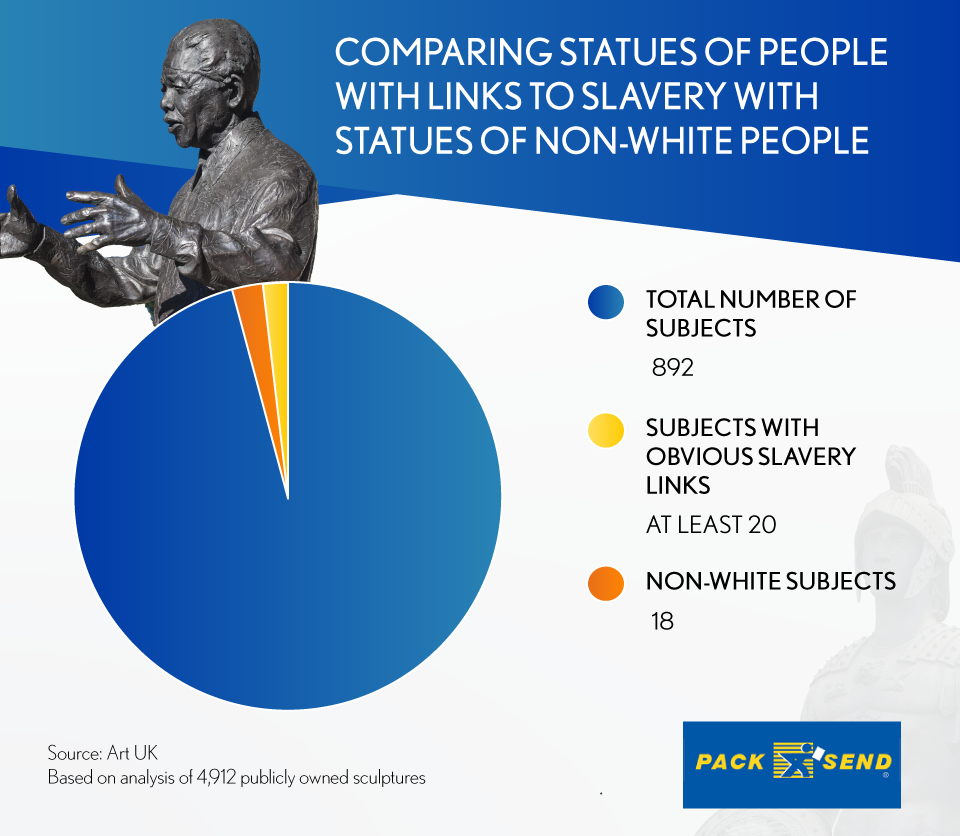
News
 Back to news
Back to newsUK Publicly Owned Statues & Monuments Illustrate Historical Questions on Slavery
Monday, 24 August 2020After the killing of George Floyd, an unarmed black man in Minneapolis, Black Lives Matter protests in the UK have sparked debate about the country’s history of racism and slavery.
Many of these protests have focused on the symbols of oppression found in our towns and cities. During one protest in June, a statue of Edward Colston was removed from its plinth in Bristol and thrown into the harbour–a harbour that was the UK’s largest slaving port and the source of a large proportion of Bristol’s wealth.
Colston was the deputy governor of the Royal African Company, the company with the English monopoly on slave trading. While Colston worked for the company, it transported 84,000 men, women, and children to British colonies in the Caribbean and North America as slaves. 19,000 of these people died at sea.
After Colston’s fall, public bodies across the UK have been trying to work out what to do with their monuments, especially those with links to slavery. The mayor of London, Sadiq Khan, has announced a review of the capital’s statues, street names, names of public buildings and plaques.
With this in mind, PACK & SEND has analysed nearly 5,000 publicly-owned statues and monuments to find those with explicit links to racism and slavery. We used the Art UK online database of public sculptures in the UK, along with University College London’s Legacies of British Slave-ownership project to find statues of people who directly benefited from the transatlantic slave trade.

Of the 4,912 sculptures we analysed, 892 were of named individuals. Of these, we identified at least 20 statues of individuals who directly profited from the slave trade. Some of these names are already well known, such as Colston and Cecil Rhodes. Others are less well known.
One of these is Adam Sedgwick. He was one of the founders of modern geology and his bust sits in Kendal Museum. In 1835, Sedgwick received compensation totalling half of £3,783 1s 8d from the freeing of 174 slaves on a Jamaican plantation. This would be worth over £250,000 today.
Another is Sir John Sinclair of Ulbster. He was an MP for a variety of Scottish constituencies between 1780 and 1811, with a statue in the Royal Society of Edinburgh. Sinclair made a claim for part of the £6767 4s 8d compensation for freeing 264 slaves in St Vincent but died before it could be paid to him.
Sir James Willoughby Gordon was a career soldier and MP, with a bust in the Royal Hospital Chelsea. His great-uncle owned a plantation in Antigua, which was left to Gordon in his great-uncle’s will.
Royalty also benefited from the slave trade. The Royal African Company was set up by Charles II in 1660. Charles and his queen, Catherine of Braganza, also invested their own money–each investment worth over £25,000 today. Subsequent monarchs profited from the company’s trading in slaves until its dissolution in 1752.
Finally, many well-known British figures with statues are linked to slavery. James Watt, famous for his engineering work that contributed heavily to the Industrial Revolution, trafficked child slaves as a young man.
Admiral Horatio Nelson, hero of Trafalgar, wrote in a private letter that he was a friend to the colonial system and railed against “the damnable and cursed doctrine of Wilberforce and his hypocritical allies.”
William Pitt the Younger, 18th century politician and Prime Minister, ordered the invasion of the French colony of St Domingue (Haiti) to suppress a slave revolt, restore slavery and bring it into the British Empire.
William Gladstone, 19th century Prime Minister, was the son of one of the largest slave owners in the British Empire. Gladstone helped his father secure over £100,000 in compensation when slavery was abolished.
Identifying problematic statues is just the start. Even this is difficult due to the sheer number of statues and deciding what counts as an explicit link to slavery. Then the issue becomes what to do with them. Removal, relocation and amendments are just some of the options.
Methodology
4,912 publicly owned sculptures were identified using the Art UK online database
For each sculpture, its title, artist, location and work type were extracted. From this information, 892 sculptures of named individuals were identified.
These individuals were cross-checked against the University College London Legacies of British Slave-ownership project and other online records to find those with clear links to the transatlantic slave trade.
